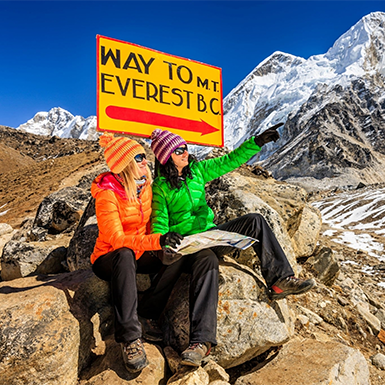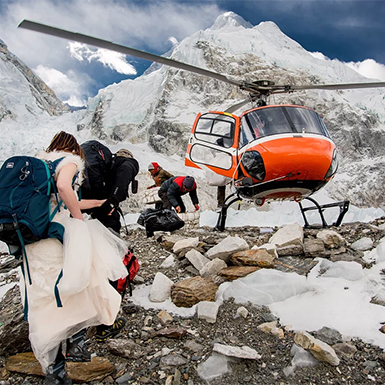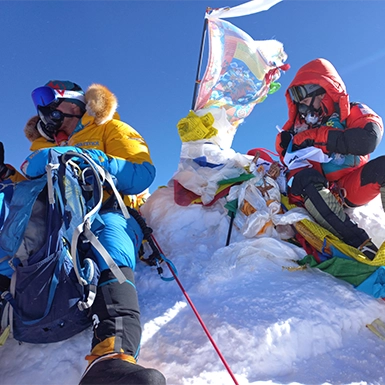Imagine stepping into a maze of towering ice and bottomless cracks in the dark of night. That’s what climbers face in the Khumbu Icefall – a frozen cascade of glacier ice on Mount Everest. It is as breathtaking as it is deadly. Every climber attempting Everest via Nepal must confront this obstacle above Base Camp. Among all Everest icefalls, the Khumbu Icefall is the most infamous. It has claimed many lives. It also tests even the most skilled climbers with its constantly shifting dangers.

What is the Khumbu Icefall?
The Khumbu Icefall is essentially the Khumbu Glacier Icefall – a section where the Khumbu Glacier tumbles over a cliff on Mount Everest. Think of it as a giant frozen waterfall made of ice instead of water. As the glacier flows downward, it cracks and breaks apart. The result is a chaotic landscape of seracs (towering ice blocks) and crevasses (deep fissures in the ice). This ever-moving river of ice lies between Everest Base Camp (around 5,364 m) and Camp I (about 6,000 m) on the mountain’s southwest side. In other words, it’s the gateway climbers must pass through to reach the Western Cwm Valley on the route to Everest’s summit. The entire Icefall is constantly shifting. The glacier here can move roughly 1 meter per day. This rapid movement makes the terrain extremely unpredictable.
Location & Importance
The Khumbu Icefall sits at the foot of the Western Cwm and the head of the Khumbu Glacier, just above Everest’s South Base Camp in Nepal. This location is a crucial part of the classic South Col route. This route was first pioneered by Sir Edmund Hillary and Tenzing Norgay in 1953. There is no easy way around it. Any team aiming for Everest from Nepal must navigate this ice maze. Climbers usually establish Base Camp right below it. Camp I is located just beyond the top of the Icefall.
Conquering the Khumbu Icefall is a key milestone in every south-side Everest climb. It’s a rite of passage for Everest climbers. The Icefall also holds cultural significance. Before starting their ascent, Sherpa guides and climbers have a Puja ceremony at Base Camp. They pray for safe passage through this dangerous section. The Khumbu Icefall is the gateway to Everest’s upper slopes. Everyone treats it with respect.
Dangers of the Icefall
The Khumbu Icefall is notorious for its hazards. It isn’t called Everest’s most dangerous section for nothing. Key dangers include:
- Unstable Ice Towers (Seracs): Huge ice blocks can collapse without warning. Even the most skilled climbers can’t predict when a towering serac will crash down.
- Such a collapse often triggers an avalanche of ice that roars down the slope.
- Deep Crevasses: The Icefall is riddled with gaping crevasses – giant cracks in the ice. Some of these openings are over 100 m deep.
- Many are hidden under fragile snow bridges that can suddenly give way under a person’s weight. Falling into one of these chasms is almost always fatal.
- Avalanches: Avalanches are a constant threat here. Snow or ice can thunder from above, often triggered by shifting glaciers or collapsing seracs. In 2014, a massive ice avalanche off Everest’s west shoulder swept through the Icefall and killed 16 Nepali guides. It was one of the deadliest events in Everest’s history.
- Thin Air & Extreme Cold: The Khumbu Icefall sits at an extremely high altitude (around 5,500–5,800 m). The air is skinny, exhausting every step and slowing your reactions. Temperatures often stay far below freezing. A climber stuck waiting in the Icefall can get frostbite in minutes. Altitude sickness (headache, dizziness) can also strike here. Any weakness or delay in such a perilous place can turn deadly.

These dangers make the Khumbu Icefall the most treacherous Everest climb. Over the years, dozens of people – the majority of them Sherpa guides – have been killed in this stretch. No other part of the standard route has claimed as many lives. Even the fittest, best-prepared climbers move through the Icefall with extreme caution. They know how powerful and unforgiving it is.
How Climbers Cross the Icefall
Crossing the Khumbu Icefall requires courage, careful planning, and special techniques. Here’s how climbers get through this ever-changing ice jungle:
- Icefall Doctors & Route Preparation: At the start of each climbing season, a unique team of Sherpa guides called the Icefall Doctors enters the Icefall first. They scout the safest route and install ladders and ropes to create a path. These unsung heroes do the most dangerous job. They risk their lives to build and maintain the route for other climbers.
- Aluminum Ladders: Dozens of lightweight aluminum ladders bridge crevasses and ice walls. Sherpas lash them together to span impossibly wide gaps. Climbers then carefully inch across these swaying ladders one by one, gripping the side ropes. It’s a nerve-wracking walk with a vast void below.
- Fixed Ropes: Sturdy ropes are fixed along the route as handrails and lifelines. Every climber clips their harness to these ropes for safety. If someone slips or a snow bridge collapses, the rope can catch them. On steep ice sections, climbers use ascender devices to slide up the rope and carabiners to stay securely attached.
- Early Starts: Timing is critical. Teams leave Base Camp well before dawn (often around 3:00–4:00 AM) to enter the Icefall during the coldest hours. The frigid nighttime temperatures firm up the ice and slow its movement. Climbers move steadily and aim to be through the Icefall by early morning. Once the sun rises and warms the glacier, the Icefall becomes much more unstable and dangerous.
- Sherpa Support: Experienced Sherpa guides accompany every team through the Icefall. They lead, set the pace, and constantly assess the conditions. Sherpas often carry heavy ropes, oxygen, and supplies as they climb. A Sherpa might cross the icefall dozens of times in one season to ferry gear and prepare camps. Their expertise in the Icefall significantly improves everyone’s chances of a safe crossing.

Despite all these precautions, the Khumbu Icefall can never be completely safe. Climbers try to spend as little time as possible in this zone. They move steadily but cautiously, always wearing helmets and sometimes avalanche beacons for extra safety. Crossing the Khumbu Icefall is an actual test of nerves. Yet for climbers on Everest’s south side, it’s the only path upward.
Climate Change Impact
Global warming is making the Khumbu Icefall even more unpredictable. As temperatures rise, the Khumbu Glacier is melting and shrinking. The Icefall has been thinning over the years, and Everest Base Camp now sits lower because the ice beneath it has melted away. Warmer winters bring less snow to refill the glacier. Hotter spring days create more meltwater inside the ice. All this adds up to greater instability. The Icefall is moving and changing faster than before.
Scientists warn that climate change is turning the Khumbu Icefall into an even riskier obstacle. Meltwater within the glacier acts like a lubricant, causing ice blocks to slide and collapse more quickly. The Icefall Doctors have had more trouble finding safe routes in recent seasons. Poor winter ice formation and unusual heat have created more enormous crevasses and weaker ice bridges than before. If this trend continues, future Everest teams will face an even more challenging time. The safe climbing window might get shorter, and teams might have to find new routes through the Icefall.

Best Time to Climb
Choosing the right timing is crucial for a safe Khumbu Icefall crossing.
Season: The best time of year to tackle the Icefall is spring (late April to May). The weather is relatively stable during the pre-monsoon spring, and nights are cold enough to keep the ice firm. There is also a secondary climbing season in autumn (late September to November). However, the autumn season brings shorter days and more unpredictable weather. These factors can make the Icefall much riskier and more complex to manage.
Time of Day: No matter the season, climbers aim to cross the Khumbu Icefall very early in the morning. The coldest hours around dawn are when the ice is most solid. Most teams leave Base Camp by about 3 AM to get halfway through the Icefall by sunrise.
In those pre-dawn hours, the glacier is usually frozen, reducing the chance of collapsing. As soon as the sun rises and starts warming the ice, the Icefall grows more unstable. By late morning, you can often hear ice cracking and see chunks of ice breaking loose. Mid-day to late afternoon is the worst time to be in the Icefall. By that time, climbers are long gone from this area.
Famous Expeditions & Records
Over the decades, the Khumbu Icefall has been the stage for both legendary feats and tragic events:
- 1953 – First Everest Ascent: The first people to summit Everest, Edmund Hillary and Tenzing Norgay, had to find a way through the Khumbu Icefall during their 1953 climb. They proved that this intimidating ice maze could be conquered. Their success paved the way for all future south-side Everest climbs.
- 2014 – Tragic Avalanche: On April 18, 2014, an ice avalanche in the Khumbu Icefall killed 16 Sherpa guides. It was one of the deadliest incidents in Everest’s history. Most of those who died were Icefall Doctors setting up the route for other climbers. This tragedy underscored the extreme risks the Sherpas face to keep the route open.
- Sherpa Records: Sherpa climbers hold virtually all the Everest climbing records, including countless trips through the Icefall. Kami Rita Sherpa, for example, has reached the summit of Everest 28 times – more than anyone else.
- Each of those climbs required multiple journeys through the Khumbu Icefall. It’s fair to say he knows this place better than anyone! Achievements like this highlight the vital role of the Sherpa community. Their skill and bravery in the Icefall make so many Everest climbs possible.
- Speed and Endurance: There is no official speed record for crossing the Icefall (safety comes first), but Sherpas are swift. A vigorous, acclimatized climber can go from Base Camp through the Icefall to Camp I in as little as 2–3 hours. In the early days of Everest, climbers sometimes took 10–12 hours to haul their loads through this section. Today, most climbers cross faster with fixed ladders, ropes, and modern gear. It takes them only a fraction of the time it took the pioneers.
- Notable Perspectives: Many famous climbers have described the Khumbu Icefall with awe. Reinhold Messner – the first person to summit Everest without supplemental oxygen – called the Icefall one of the scariest parts of the climb. Modern team leaders brief their clients thoroughly about this section. Even Everest veterans like Bear Grylls and Ed Viesturs approached the Icefall with great caution. Its fearsome reputation ensures that everyone gives the Khumbu Icefall the respect it deserves.
Nearly every south side Everest climb has its own Khumbu Icefall story – sometimes of triumph, sometimes of close calls. From the first ascent in 1953 to the challenges of today, this shifting maze of ice has seen it all. It has been the scene of both glory and tragedy on Everest.
Tips for Adventure Enthusiasts
Dream of one day climbing through the Khumbu Icefall? Preparation is key for any adventure enthusiast considering such a challenge (or even high-altitude trekking). Here are some tips:
- Build Your Climbing Skills: Before attempting Everest, get comfortable with basic mountaineering skills. Practice walking on ice in crampons. Learn how to use an ice axe, and consider taking a course on crevasse rescue. Climb smaller peaks or ice walls to get used to ladders and steep ice in a safer setting.
- Train for Endurance: The Icefall demands fitness. Train for months to build your strength and stamina. Do long hikes, climb stairs with a weighted pack, and keep up cardio workouts. Strong legs and core muscles will help you stay steady on uneven ice. Arrive in Nepal in your best shape. Every step feels twice as hard at high altitudes, so you need all the fitness you can get.
- Acclimatize Properly: Give proper time for your body to adjust to the thin air. Most Everest teams spend a few weeks at Base Camp (around 5,300 m). They climb up to higher camps and then return down to build acclimatization. Never rush this process. If you feel symptoms of altitude sickness (like a bad headache or dizziness), rest or descend until you recover. Climbers who acclimatize well move much more confidently through the Icefall.
- Go with Experts: Don’t go it alone. If you’re not a professional alpinist, join a reputable guide company like Peregrine Treks and Expedition for Everest. We will provide experienced Sherpa guides and a support team that knows the mountain. Our professional team sets the ropes and ladders and leads you safely through the Icefall. Following their guidance dramatically increases your chances of success.
- Use Quality Gear: In a place as unforgiving as the Khumbu Icefall, reliable gear is essential. Invest in high-quality mountaineering boots and layered clothing for extreme cold. Use a good helmet and a climbing harness with safety lines and ascenders. Don’t forget insulated gloves and snow goggles. Test all your gear beforehand to ensure it fits well and works in subzero conditions.
- Stay Aware & Respect the Mountain: Mental preparedness is as important as physical training. Be ready for very early starts and tough decisions on the climb. Stay calm and focused in dangerous spots. Always listen to your guides’ instructions in the Icefall. If they say wait or turn around due to conditions, trust their call – it could save your life. Patience and humility go a long way when facing Mother Nature at 7,000 m.
Following these tips will significantly improve your safety and confidence if you venture into the Khumbu Icefall or any high-altitude climb. Remember, Mount Everest isn’t going anywhere. The real goal is to enjoy the adventure and come back safely.
Experiencing the Icefall Safely
What if you want to witness the Khumbu Icefall’s grandeur without climbing it? Fortunately, there are ways to see this spectacle up close while staying safe. Trekkers and other visitors can marvel at the Khumbu Icefall without setting foot on it:
- Trek to Everest Base Camp: This trek brings you right to the foot of the Khumbu Icefall. At about 5,364 m, Base Camp offers a front-row view of the lower Icefall. Base Camp is full of climbers’ tents in the spring climbing season. From there, you can gaze up at the towering ice seracs of the Icefall from a safe distance. You might even hear the distant rumble of the glacier shifting or witness an avalanche high on Everest’s slopes. It’s an awe-inspiring experience. Best of all, it requires no technical climbing.
- Kala Patthar Viewpoint: For a broader panorama, many trekkers hike up Kala Patthar (5,545 m), a hill near Base Camp, often at sunrise. From the top of Kala Patthar, you get a stunning view. You can look down on Base Camp. The Khumbu Icefall snakes up between Everest and Nuptse. It’s one of the best photo opportunities in the Himalayas. You can see Everest’s summit, the Khumbu Glacier, and the Icefall all in one view.
- Helicopter Tour: If trekking isn’t an option, helicopter tours are another way to see the Khumbu Icefall. Helicopters can fly from Kathmandu and land at Everest Base Camp or nearby. You get a dramatic bird’s-eye view of the entire Icefall from the air. The colorful tents of Base Camp look tiny next to the gigantic ice blocks. Be sure to choose a reputable pilot. Also, remember that flights depend on good weather.
- Visit During Climbing Season: Base Camp will buzz with activity if you time your trip for the busy spring climbing season (April–May). You may meet climbers or Sherpas and hear first-hand stories about the Icefall. You’ll also see the ladders and ropes in place on the lower ice. Sometimes, with an experienced guide, trekkers can carefully step onto the very edge of the Icefall for a brief look. This gives a tiny taste of the Icefall’s conditions. Of course, it’s only done under strict supervision with proper gear.
- Learn at a Mountain Museum: Prefer to stay at lower altitudes? You can still learn about the Khumbu Icefall’s wonders. Museums like the International Mountain Museum in Pokhara or the Sherpa Museum in Namche Bazaar have exhibits on Everest’s glaciers and climbing history. You can see photos and models of the Khumbu Icefall and appreciate its scale. And you can do it all while keeping your feet on solid ground.
By choosing one option from the five alternatives, you can enjoy the thrill of the Khumbu Icefall without the risks of climbing it. You might watch snow plumes dance off Everest’s summit from Kala Patthar. Or you might stand among the prayer flags at Base Camp. Either way, seeing the icefall will leave you in awe. It’s a powerful reminder of nature’s raw strength. This frozen waterfall beckons adventurers, even as it commands their respect.



